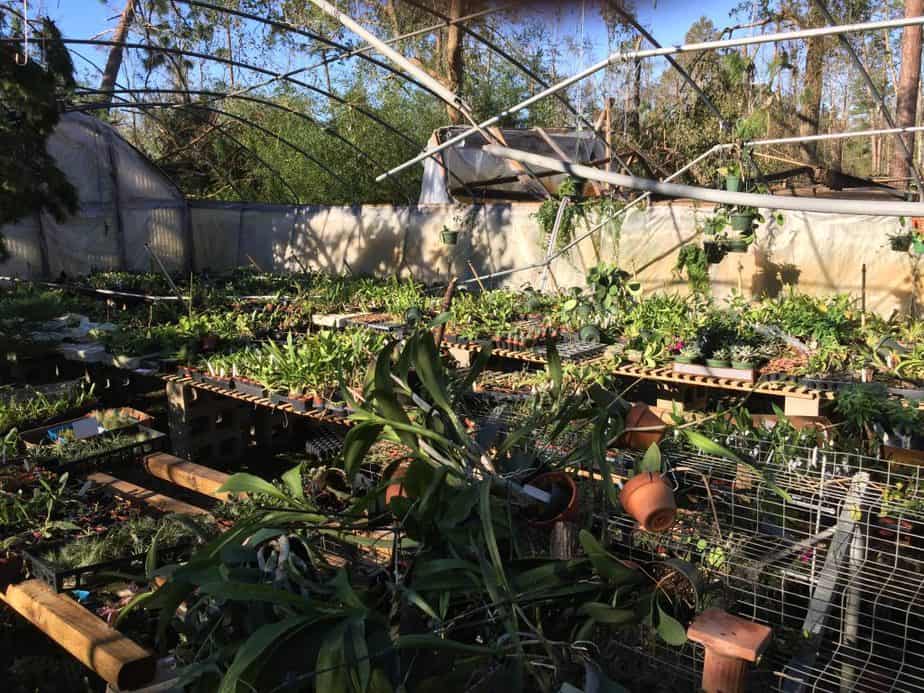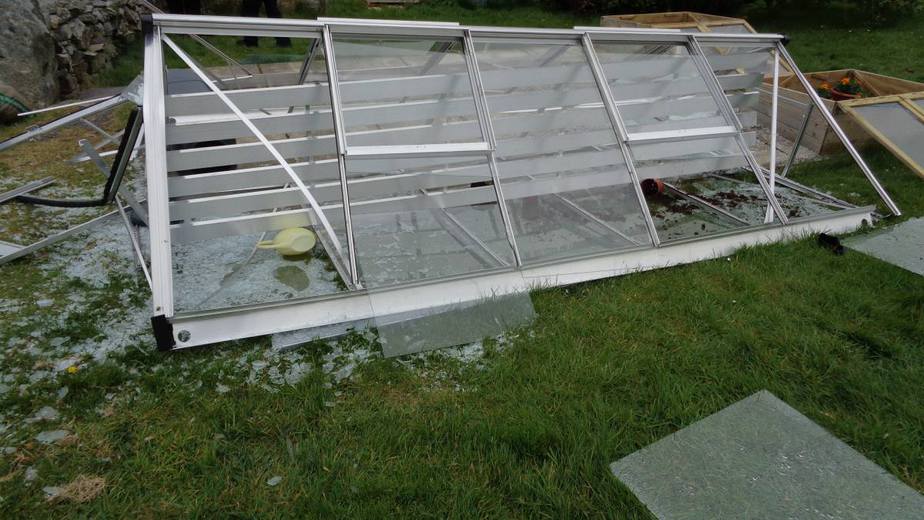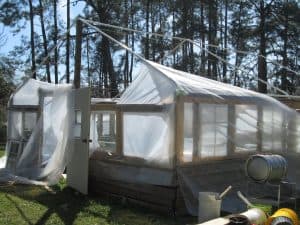You can’t stop the wind. Boreas, Zephyros, Notus, and Eurus have been wreaking havoc on demigods and heroes for centuries – you really thought they were going to leave your backyard greenhouse alone?
Even though a greenhouse provides your plants with more protection from elements than a garden without coverage, extreme weather still poses a threat to your backyard greenhouse. So, how to protect a greenhouse from wind?

Wind can be extremely damaging to a greenhouse if you don’t prepare for it.
Just like any natural climate factor, wind is impossible to predict—but it is possible to plan for.
Can the wind pick up my greenhouse?
The answer is yes, absolutely. Now, it all depends on if your greenhouse is made out of heavy materials (glass and metal) or lighter structural elements (like PVC pipe and polyethylene sheeting), as well as other factors.
But don’t discount the Wizard of Oz scenario just because it seems outlandish. That smaller and lighter you greenhouse, the higher the chance that you greenhouse could get swept up just like Dorothy’s house.
Elements that can contribute to wind damage:

Site exposure
Is the location of your greenhouse exposed to wind gusts? If you live in an area that gets hit with high winds, like a ridge, gorge, hilltop, or plain, it’s especially important that you consider where to place your greenhouse on your property.
House shape
Objects with large, flat surfaces catch wind much easier and can be susceptible to wind damage.
Consider a sailboat! Or think about a bicyclist couchin into aerodynamic position or wearing a sleek, tear-drop-shaped helmet. The elimination (or minimization, at least) of flat surfaces helps eliminate wind-catching drag.
The same goes for your greenhouse. Learn about the different types of greenhouses available to you to choose the right option for your needs.
Roof slope
Another aspect of the shape of your greenhouse, the slope of the roof can contribute to how vulnerable to wind damage your greenhouse is.
Some slant in the roof of a greenhouse is always preferred, especially in areas of heavy rain or any snowfall. But a very slanted roof can pick up more wind.
A domed roof is even less susceptible to wind damage, but these are rare.
Height
The taller the structure, the more wind it will catch! Just ask the tallest trees in your yard. If you live on the plains or the top of a hill or mountain, it’s a good idea to go with a lower-profile greenhouse.
Tips to Protect a Greenhouse from Wind
When choosing, building, and installing your greenhouse, you can make significant choices that will help protect it from wind damage. Even before you build your greenhouse, consider taking a close look at these factors to reduce the risk of problems with wind.
Choose the Ideal Location
Does your yard have lots of tree branches? Which parts of your property are most wind-heavy? Which way do the largest walls and roof surfaces of the greenhouse?
Consider the wind patterns and other “flying” objects on your property for greenhouse placement.
Sometimes this can’t be a primary focus of installing your greenhouse, because orientation toward the sun is much more important than avoiding any wind interference. Additionally, most places can experience harsh winds from many directions.
But it’s worth a look to see if you can eliminate wind danger by orienting your greenhouse in an “aerodynamic” way.
If it fits your budget and zoning allowances, building a greenhouse that is directly attached to another structure (one with a foundation).
Consider a Greenhouse Foundation
It’s pretty uncommon to build a “real” foundation for your greenhouse (like concrete or some other heavy material), but it’s absolutely possible. If you live in an extreme wind-threatened area, you could consider starting your greenhouse build with a foundation.
Anchor your Structure
To save some money and a lot of effort, you can also anchor a lightweight greenhouse with concrete blocks, bricks, or other heavy objects.
This can be especially useful for houses made out of plastic sheeting and hoop houses.
You can also enhance the structural strength of your greenhouse by installing some two-by-fours or even some semi-heavy piping to reinforce the frame—across the roof eaves or from eave to foundation. Be sure these are installed securely!
Looking for more guidance on building a sturdy, long-lasting greenhouse? Check out our guide to The Ins and Outs of Building Your Own Greenhouse.
Consider Insurance (Seriously, This Isn’t A New iPhone)
It’s a good idea to inform the company that provides your home insurance that you’ve installed a greenhouse. That way, if anything happens to your greenhouse, you’re covered.
Although, be careful with weather-caused damage, as some isn’t covered by certain insurance policies. Always check what your insurance policy covers with your agency or provider instead of assuming weather damage is covered!
Preparing Your Greenhouse for Windy Weather

When you know windy weather is on the way, you can prepare your greenhouse to prevent damage.
Regular maintenance on your greenhouse’s structure will also help prevent wind damage when storms roll through. Chances are that if it’s windy, it’s probably cold too – let’s winterize that greenhouse.
Check the structure
Look at the frame of your house to ensure it’s in good, sturdy shape.
Tighten bolts, make sure support beams are solid (especially if the frame is made of wood), and look at foundational brackets on the frame. These can all loosen over time!
Inspect the area
Check the area around your greenhouse to clear it of objects that might be picked up and tossed by the wind.
Some things to look out for:
- Weak or dry tree limbs
- Boxes or buckets that you might keep around the yard
- Yard and garden tools
- Decorations on or around your home (flags, etc.)
Close windows, vents, and doors
If wind rips through your greenhouse, you’re out of luck. The force of the wind will multiply if it gets inside the building, especially since your greenhouse was built for optimum ventilation and airflow.
Don’t let your greenhouse become a wind tunnel!
Inspect glazing
Check your greenhouse’s glazing not only for cracks, tears, or holes, but looking at the quality of attachment to the frame. Check and tighten bolts and screws. Check for gaps anywhere there should be a seal.
The weather is getting worse – how do I protect my greenhouse from wind?

It’s worth noting that rapid climate change and the effects on weather make this discussion not only somewhat tenuous and unpredictable, but also quite unsettling. When we talk about climates prone to tornadoes or hurricanes, we used to be able to speak of quite isolated and predictable areas.
Now, as we see the massive effects of the many-layered changes to the earth’s climate, including atmospheric warming, ocean acidification, sea level rise, ecosystem depletion, drought, and so much more, it’s challenging to know where these extreme weather events won’t strike.
The good news: the greening of your own lifestyle, like growing organic food in your own greenhouse, can help heal the planet.




